By Jeffrey A. Rendall, Photos by Chuck Rendall
KAPALUA, MAUI, HI – “Bill, it rises gently from the sea,” remembered Bill Coore, in thinking back to how partner Ben Crenshaw described the nature of the land on a potential new golf course venture at Kapalua on the west side of Maui in the late 80’s.
Seeing as two-time Masters Champion and ’99 Ryder Cup Captain Crenshaw wasn’t known for hyperbole in discussing golf course properties, Coore took his partner at his word in assessing the land’s ultimate potential – and what resulted a few years later was the Plantation Course at Kapalua, a golf course many of us are intimately familiar with, having seen it every year on TV as the host of the PGA Tour’s annual opening tournament, the Mercedes-Benz Championship.
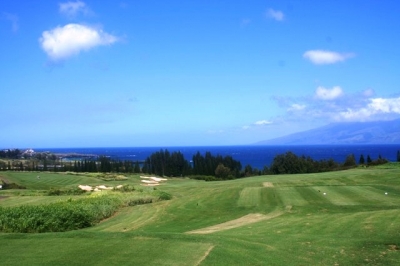 |
| One of golf's greatest feelings - standing on the tee of the Plantation Course's 1st hole with a downhill shot and the wind at your back. |
Crenshaw had been playing in the old Kapalua Invitational at the time (again, the late 80’s), and was approached by TV commentator and Hawaii resident Mark Rolfing for his thoughts on a large plot of land and its prospects for building a championship-level golf course that could one day host a regular PGA Tour event. Coore said Rolfing (who was a partner at Kapalua’s developer, Maui Land and Pineapple Co.) and Crenshaw essentially checked out the much flatter lower portions of the property, and hence, Crenshaw’s initial assessment of the ‘gentle’ slope of the land.
“We still kid Ben about it to this day,” Coore added. Because upon further investigation, the design team discovered that the Kapalua pineapple fields, rugged natural areas and ravines that would eventually shape the course were anything but ‘gentle’ – quite to the contrary, in fact.
At least Crenshaw got the ‘slopes from the sea’ part right.
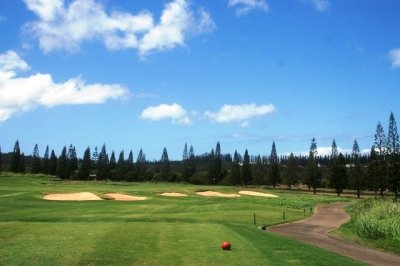 |
| Here's a rare view at the Plantation Course - the perfectly flat par three 2nd hole. |
Despite Crenshaw’s initial miscalculation as to the property’s topsy-turvy topography, both men agreed that the eventual final product was worth all the effort it took to find a workable way to place a golf course on one of the world’s most beautiful pieces of earth – with scenery so stunning that adding golf to it could only serve to mix two of life’s true pleasures, viewing nature’s awesome beauty and playing the grand and ancient game of golf.
Coore said the team realized soon after starting that building a golf course at Kapalua would be no easy undertaking. In addition to the difficulty of routing a layout on some narrow slivers of land heading up and down the mountainside, they could only build three or four holes at a time due to Hawaii’s environmental permitting process. “We’d put irrigation in, grass them, and then move on, to keep the erosion possibilities down. So even though it was in Hawaii where the weather cooperates year-round, it took two years to build the Plantation Course,” Coore explained.
Coore continues, “We knew the golf course was going to be visually spectacular – there was no question, the views and the setting were just sensational. By the same token it was a tough piece of property to lay the golf course out because the upper part of the property was so severe – narrow fingers of land that sweep towards the ocean bisected by some huge ravines which prohibited going crossways.”
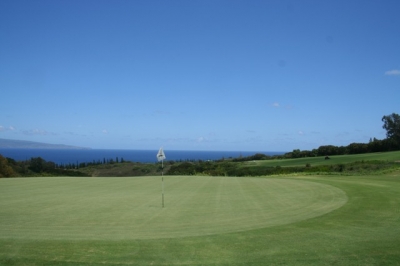 |
| Looking back from the green of the par five 5th hole. Going slightly uphill and often against the wind, it plays longer than its 532-yards would suggest. |
And yet they wanted a very traditional golf course on a very non-traditional piece of property. The solution? Build to scale. Everything at the Plantation Course is big as a result. You’ve heard the TV announcers talk about it – 100-yard wide fairways in some spots, humungous bunkers, gigantic greens and of course, big-time scenery.
Crenshaw and Coore are both from Texas, but this particular parcel of Pacific Hawaiian island is a long way from the Lone Star State. It hardly matters – this ‘big’ golf course could snuggle up nicely to any of the grandest features in Texas.
“We built the course to such a large scale at Kapalua for two reasons,” Coore elaborated. “First, because everything you see out there is so monumental. And then, because of the trade winds and slope of the property.”
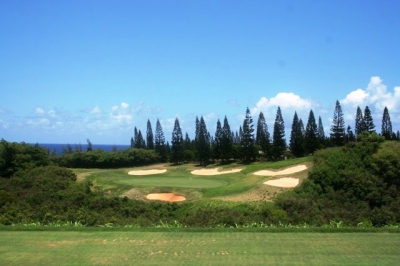 |
| The par three 8th hole looks benign, but miss the green and you're probably in trouble. |
Wind and slope – two factors that can’t be ignored on the Plantation course, and in case you temporarily forget, there’s always the next shot to remind you. You get the impression that a ‘regular’ golf course on this site just wouldn’t work, and that was the impression Crenshaw and Coore took away as well.
“If we’d tried to build a more ‘conventional’ golf course in terms of size of features, not only would it look miniscule out there, you just could not have played it,” Coore lectured. “Trying to hit forty or even fifty-yard wide turf surfaces off of some of those tee boxes with the trade winds blowing, it would’ve been an exercise in frustration. We realized we’d need a lot of room to play when we stood up there and compared tee locations to where the landing areas were.”
Coore reminded me that the pros weren’t the only ones to take into consideration. Though the course was certainly designed with attracting a professional tournament in mind, it also had to cater to tourists and recreational players the rest of the year. From personal experience, the big surfaces add the necessary element of confidence even when the wind’s blowing ‘moderately’ (in the words of the Plantation’s Head Professional, Scott Carroll) at 30 mph, as it was the day we played.
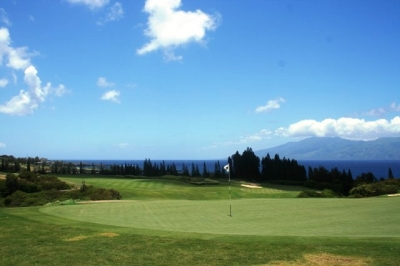 |
| One of the most beautiful holes in Hawaii, the par five 9th at Kapalua's Plantation Course - it's also one of the hardest you'll ever play. |
Because of the scale of the course and the prevailing conditions – slope and wind – you may have to employ a different playing strategy, as Coore explains. “Even with the big targets out there, you can’t necessarily play the Plantation course from point A to B to C, strictly in the air. You’ve got to be able to use the ground – the slopes, the tilts – you’ve got to figure out a way to use the ground to your advantage, kind of like in the old country. You’ve got to identify a target and figure out how to get there – and it’s not always in a straight line.”
By the same token, just because the playing surfaces are exceedingly large, it doesn’t mean you can just bang away out there and still post a great score. Like all thoughtfully designed golf courses, the Plantation course requires you to pick a line, challenge the hazards and make some shots in order to score well.
Coore elaborates: “Even though the fairways are just gigantic, the best lines to play on most of the holes force you to play along the margins – and when you start getting greedy, that’s when you can get in trouble. That’s how you can watch the tournament on TV and the commentators are talking about the fairways being 80, 90, 100-yards wide, and the best players in the world are still hitting it in the bushes.”
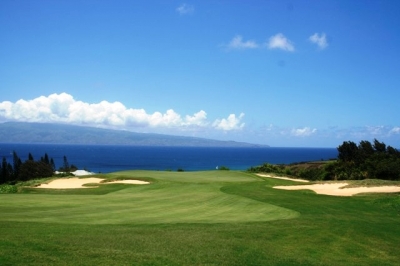 |
| Looking towards Honolua Bay from the par three 11th tee - it looks like you're firing right into the Pacific Ocean. |
True, the most direct lines often bring trouble into the equation, but there are always ample bailout opportunities – and if you play from the correct set of tees, the margins for error are really quite wide. The Plantation course could easily be the ‘easiest’ tough course in the world if you play it correctly from tee to green.
The walk in the park ends when you reach the greens, however. As mentioned above, the greens are exceedingly large, but they’re also sloped and grassed with Bermuda, which mandates attention to the grain. All the putting challenges are there at Kapalua: long putts, grain, big slopes, wind and pressure to avoid three-putts. It’s unfortunate that you can’t bring along a putting master like Ben Crenshaw to strike your putts for you.
It’s obvious from talking with Coore that he and Crenshaw take pride in their work on the Plantation course, but the Kapalua folks are just as satisfied. The relationship is a continuing one, as Coore and Crenshaw still visit regularly to look after things and suggest improvements. It’s the type of ongoing, personal care that the developers wanted in the first place.
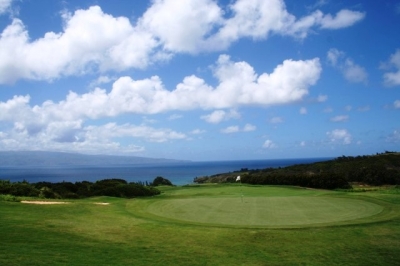 |
| Playing 305-yards, uphill and into the wind, the pros still sometimes try for the green from the tee on the 14th hole - for the rest of us, it's a challenging short par four. |
Kapalua’s VP of Resort Operations, Gary Planos, said they chose Coore and Crenshaw for more than just their reputations – it was because they’d take the project personally. “Mark Rolfing wanted to work with Coore and Crenshaw because he knew we had a truly unique piece of property (240 acres), and we needed a design team that could spend the necessary time here to make this a success – and Bill and Ben proved him right. They must’ve visited this site a dozen times each during the design and construction of the golf course.”
The Plantation course’s Director of Golf, Mike Jones, says they still come around, too. “Bill regularly attends the Mercedes Benz Championship and we talk with them frequently about the course and any possible changes and improvements.”
When discussing the Plantation course’s playing attributes, Jones again returned to the theme of slope and wind – but he also talked about the two combined: “Most of the time we have a trade wind, but if you get a rare Kona wind, the course plays tougher as some of the long downhill holes would then be playing into the wind.”
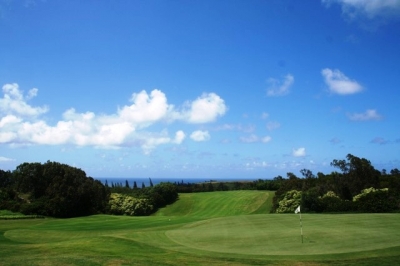 |
| The par five 15th hole is a good example of the Plantation Course's playability and challenge - it's a relatively easy par but you'll need to earn a birdie. |
Jones continues, “Coore and Crenshaw did a wonderful job with the course’s design, as most of the elevation changes play downhill. The uphill holes, and there are some, are not as severe (uphill) as the downhill holes. The longer holes also play with the prevailing trade winds, so there’s an additional advantage for the players.”
The Plantation course is one of those layouts with eighteen ‘signature’ holes, but favorites included the famous par four first hole (the one you see quite a lot on the Golf Channel). The pros play it at 520 yards, but it’s downhill and with the prevailing wind, as Jones described above. The regular tees cut the distance to 434 yards, which makes it a drive and a mid-iron for most folks.
The par three eighth hole is another famous link, playing over a canyon to a large green well protected by bunkers. Jones describes it: “From the tee it looks intimidating but usually plays down/crosswind and downhill. The green has a ridge across the middle that makes it challenging. A deep bunker in front of the green encourages you to play an extra club to avoid it.”
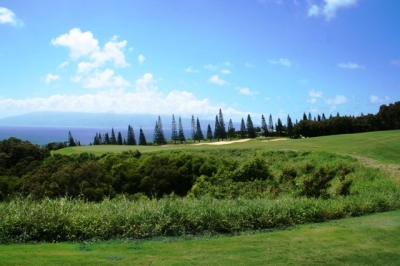 |
| The second shot on the par four 17th hole is pure intimidation - you can try and fly it to the green, or bail to the right. |
The par three eleventh is another charming one-shotter that plays towards Honolua Bay – breathtaking views and quite a challenge to choose the right club to hit this relatively small target. Head Pro Scott Carroll told us that this is one hole he never seems to get right, because the wind conditions make club selection so difficult.
Finally, the eighteenth hole is a finishing classic – a lot of fun to play and to watch the pros try to hit the green in two. Again, Jones tells us about it: “Off the tee you aim at the chimneys on the clubhouse and let the slope carry your ball down the hill – and a good tee shot may get you home in two. From the tee you have a great view of Molokai (the island ‘next door’) and expansive views of the Pacific Ocean in front of you.”
Playing the Plantation course is an experience that shouldn’t be missed if you’re heading to Hawaii. Not only is it fun to walk in the shoes of the pros who hit the same shots every January, it’s an architectural masterpiece that’s worth a look in and of itself.
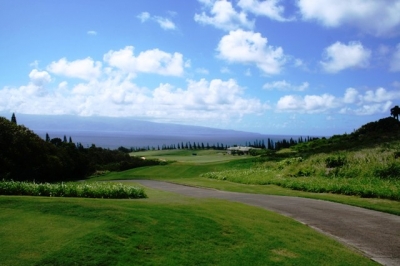 |
| Standing on the tee of the par five 18th hole, you get a sense of history as you walk in the footsteps of the greatest players of the game. |
We’ll leave the last word to Jones: “We want our players to walk away knowing they played a great golf course, received great service from the staff, and looked at the most beautiful scenery in the world. We want to turn them into avid Kapalua fans who will tell others about the course and their experience.”
And once they tell their friends, just maybe they’ll describe it in a way their friends will never forget… just as Ben Crenshaw did to Bill Coore, all those years ago.
Details:
2000 Plantation Club Drive
Lahaina, Maui, HI 96761
Phone: 1-877-KAPALUA
Website: Kapalua.com
Course Designers: Ben Crenshaw & Bill Coore
VP of Resort Operations: Gary Planos
Director of Golf: Mike Jones, PGA
Head Golf Professional: Scott Carroll, PGA
Tees/Yardage/Rating/Slope
Tournament 7411 75.6/140
Championship 7263 74.9/138
Regular 6547 71.7/130
Forward 5627 73.2/129
Rates:
Check the Kapalua website for current rates.
Kapalua does offer some great “stay and play” packages, including new “Unlimited Golf” – Check the Website.
| Related Links | Comments on this article? | |
|
Maryland National Golf Club Hollow Creek Golf Club Rocky Gap Resort PB Dye Golf Club in Ijamsville Whiskey Creek Golf Club |
E-mail Jeff Rendall, Editor: jrendall@golftheunitedstates.com |












